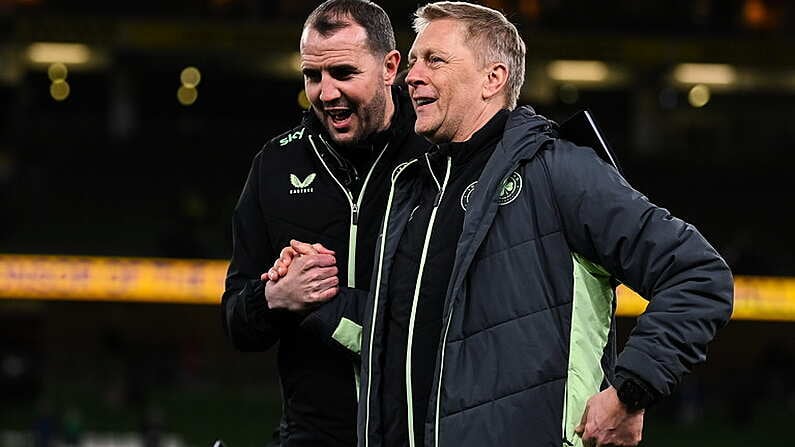First Estonia, and now Denmark: the Republic of Ireland have developed a useful habit of winning draws. Going by the FIFA rankings, Denmark were the side to get, given that they were the lowest-ranked of the seeded teams, and they were also not Italy or Croatia, countries who bring with them uneasy reminders of the trauma of E**o 2**2.
After the jubilation at drawing the Danes came the backlash, that drawing a team that are still better than us should be no cause for jubilation; our premature hollering was exactly that.
So where does the truth lie? How good are Denmark? We've been finding out.
Style of Play
The perception of Denmark in their own country is virtually the opposite to how Ireland are viewed here. While virtually every Irish performance is met by the espousal of anguished hopes that we get the ball on the ground and pass it around a bit more, Denmark have had their fill of possession football. The previous manager Morten Olsen imposed a possession-based style on the side across his fifteen years in charge, but results were mixed: Denmark qualified for half of the major tournaments staged under his watch.
The end of his regime was marked by largely impotent possession. Denmark had 60% of the ball in both legs of their Euro 2016 playoff against Sweden, yet still did not qualify for the tournament. Poul Ferdinand has been covering the Danish national side for ten years, and tells Balls that under Olsen, Denmark played that way "almost religiously".
He describes new manager Age Hareide as "less ideological", and this qualifying campaign has been notable for a more direct style of play, in spite of the presence of Christian Eriksen. (Not that this has adversely affected Eriksen, he scored at least once in all of Denmark's last five qualifiers).
Hareide has been employing 6ft 4in striker Andreas Cornelius (formerly of Cardiff City) on the right side of attack a target for long diagonal balls, off which Eriksen and striker Nicolai Jorgensen have profited. This tactic was to the fore in Denmark's most significant win of the qualifying phase: a 4-0 win at home to eventual group winners, Poland.
As to whether Hareide changes this tactic given Ireland's strength in the air, Ferdinand is unsure.
This tactic's success has earned Hareide the support of Danish fans.
In Denmark, we were brought up with a certain idea of how we play football, but that may have stemmed from the fact we had such great players in the 1980s but it got to a point that people were so indifferent to the team [under Olsen]. Denmark had loads of the ball but were impotent, and didn't do anything with it, so didn't make it to many of the major tournaments. So maybe ten or twelve years ago we mocked direct football as an old-style, British way of playing football, but now everyone appreciates that Age Hareide plays to the team's strengths, so he has some credit there.
Formation
We're likely to see Denmark play a 4-3-3 against Ireland. Kasper Schmeichel is the first-choice goalkeeper, and will play behind a defence somewhat troubled by injury. All of those in doubt ahead of the Irish tie, however, have been passed fit. (There had been concerns over the fitness of defenders Simon Kjaer and Andreas Bjelland along with striker Jorgensen). Denmark will be without regular right-back Henrik Dalsgaard, however, who is set to be replaced by Peter Ankersen of FC Copenhagen, with Udinese's Jens Stryger Larsen (usually a right-back) likely to play at left-back to deputise for the injured Riza Durmisi.
The midfield three will almost certainly be William Kvist, Thomas Delaney, and Eriksen, with Jorgensen leading the line flanked by Pione Sisto of Celta Vigo and probably Cornelius, although RB Leipzig's Yussuf Poulsen is in contention to nab his place. Nicklas Bendtner will almost certainly be on the bench.
Among the more notable names unlikely to be involved are Ajax attacker Kasper Dolberg and Chelsea defender Andreas Christensen. Dolberg has failed to replicate his form of last season, and is instead involved with the under-21s. Christensen, meanwhile, is deemed as largely untested in a flat back four: he has excelled as part of Chelsea's three-man defence in recent weeks. This fact, coupled with the fact that Hareide trusts the Kjaer/Bjelland axis, means that Christensen is likely to be held in reserve.
Denmark's probable lineup: Schmeichel; Ankersen, Kjaer, Bjelland, Larsen; Kvist, Delaney, Eriksen; Sisto, Cornelius, Jorgensen.
The mood in Denmark
In spite of their more direct style of play, the Danish players are aware of their technical advantage over the Irish players. Ferdinand describes the mood in Denmark as "modestly optimistic", with the discourse around the Irish side focusing more on the intangible talents of Irish sides from the past, namely our old friend, "fighting spirit". The most recognisable names, says Ferdinand, are Seamus Coleman and James McCarthy, given their involvement at Everton. He rates Denmark as narrow favourites, tipping the odds 60/40 in his nation's favour.











